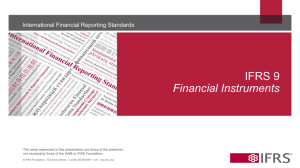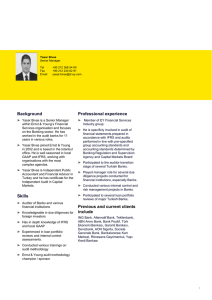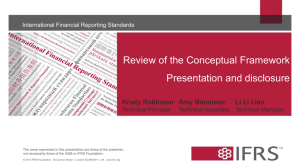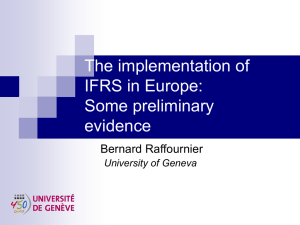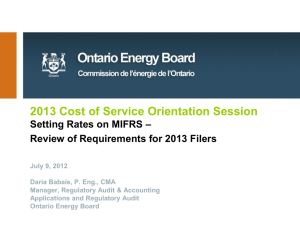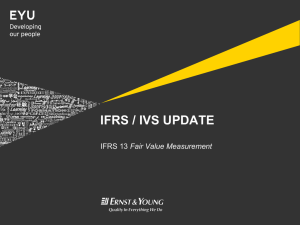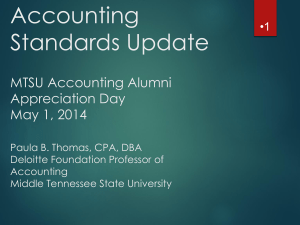Update on US GAAP/IFRS Convergence
advertisement
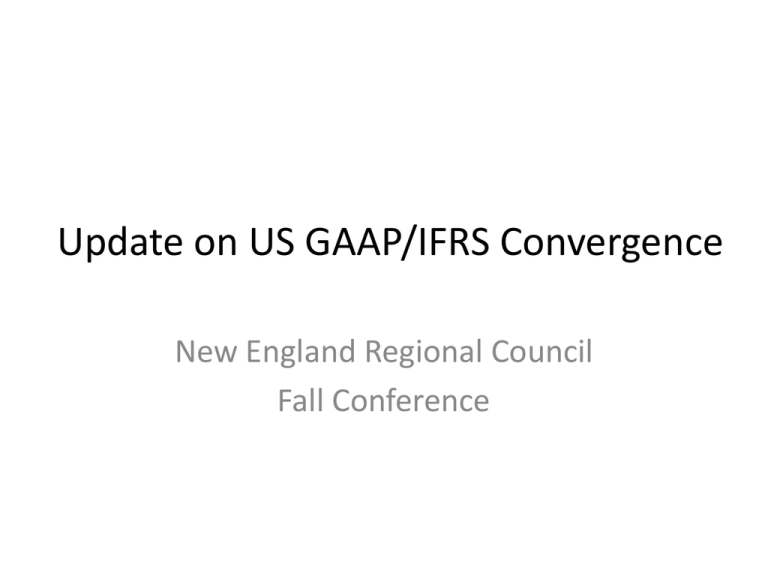
Update on US GAAP/IFRS Convergence New England Regional Council Fall Conference The Need for Convergence Net Income Calculations Around the World • United States – $20,000 • United Kingdom – $250,000 • Australia – $225,000 • Germany – $10,000 Current Status of IFRS Adoption • Two-thirds of the G20 countries have adopted IFRS • 110 countries are currently committed to IFRS • It is estimated that in a few years 150 countries will commit to IFRS Recent Adopters • 2010 – Brazil adopted IFRS • 2011-2012 – Canada, Korea and Mexico have required IFRS • China has committed to convergence • India allows IFRS for consolidated financial results only • Japan allows IFRS for selected companies that have consolidated financial statements Top 10 Global Capital Markets Country • Australia • Switzerland • Spain • Hong Kong • Germany • Canada • France • UK • Japan • US Standard Market Cap. ($ in trillions) IFRS 0.8 IFRS or US GAAP 0.9 IFRS 1.0 IFRS 1.0 IFRS 1.2 IFRS 1.5 IFRS 1.7 IFRS 3.1 Converging to IFRS 4.7 US GAAP 17.0 Failure to Adopt IFRS • Coalition of nations supporting IFRS could break apart. We could go back to the situation before 2000 – fragmentation • The U.S. could be marginalized as the rest of the world moves ahead with the use of IFRS as a global standard Questions That Might Arise • What are the key differences between the standards? • What is the impact on earnings? • What is the estimated cost of conversion? • What is the impact on systems/processes/data collection/consolidation/financial reporting • Who is impacted and what training will they receive? IFRS in the United States • The idea of a single set of global accounting standards remains a goal of the IASB, but there is no indication that the SEC will act soon to have companies adopt IFRS. • The idea of achieving global comparability is being advanced by FASB. – Journal of Accountancy January 10, 2013 Private Companies • There are roughly 5,000,000 private companies in the U.S. • In May 2008, the AICPA recognized the IASB as issuing high-quality standards on par with FASB. • They may now use IFRS and it is estimated that 5%-10% of companies do use them. – These are affiliated with foreign companies – They may want to raise capital in foreign markets Public Companies • There are about 25,000 public companies. • These companies must follow the SEC’s guidance. – The U.S. companies may not use IFRS – The foreign companies listing on U.S. exchanges are allowed to use IFRS - since 2007 The Case for the Decision to Adopt IFRS • Prior to 2001, U.S. GAAP was the gold standard and some thought the world would switch to U.S. GAAP as the international standard • In 2001, the U.S. accounted for 52% of world equity market capitalization • By the end of 2009, our share had dropped to 31%. • The world did not need to come to the U.S. to raise capital now. The Road to IFRS in the United States • The FASB and IASB issued a Memorandum of Understanding in 2002 – To make their existing financial reporting standards fully compatible as soon as is practical – To coordinate future work programs to ensure that once achieved, compatibility is maintained The Initial SEC Roadmap • Large U.S. companies would voluntarily start using IFRS • Other companies would follow in 2014 • The start date has now been moved to 2016 Possible Implementation Approaches • Adoption – U.S. adopts all IFRS standards and new standards as issued by the IASB. – FASB plays a diminished role – Only 10 countries have opted for this approach • Canada • Australia • South Africa Possible Implementation Approaches • Endorsement – IFRS are considered separately by FASB as they are issued for being acceptable for use in the U.S. – Most countries follow this approach including the European Union. The EU rejected the standard on financial instruments. – Can we have comparability with this approach? – Many countries have chosen to exclude one or more IFRS. Possible Implementation Approaches • Convergence – The IASB and FASB continue to issue their own standards but work together to achieve nearly identical standards – China and India have adopted this approach An Alternative Approach • Condorsement – The SEC suggested this in 2011. This is a framework that – Keeps FASB, but in a different role – Transitions to IFRS over a period of 5-7 years – Incorporates IFRS in to U.S. GAAP over a period of 5-7 years until it is compliant with IFRS as issued by the IASB. Arguments in Favor of Adoption of IFRS • Enhances transparency and comparability among companies globally – IFRS enables investors and other users to more readily assess performance and to make comparisons among companies. – Surveys indicate that IFRS would transform the finance function and create value. • Lower costs – IFRS present opportunities for global U.S. companies to lower costs through standardization of financial reporting, centralization of processes, improved controls, and better cash management. • Improves liquidity, valuation, and cost of capital – Research appears to show that U.S. companies would benefit financially from adopting IFRS in countries with relatively strict enforcement regimes and where the institutional environment provided incentives for more transparent earnings. AICPA • The AICPA has recommended that the SEC move immediately to allow optional adoption of IFRS by U.S. companies. • It also reports that a majority of its members have at least a basic knowledge of IFRS and support this position. Bumps in the Road for IFRS in the United States • SEC Roadmap Milestones 1. Sufficient development and application of standards • SEC found a number of areas with no guidance, policy options or industry guidance. • In a study of company reports, many inconsistencies were found and many failures related to compliance with IFRS were noted. 2. Independent funding of the IASC Foundation and the standard setting process – Funding for the foundation is approximately 50% from companies that must report using IFRS. Other SEC Roadmap Milestones • Education and training of investors relating to IFRS • Effect on U.S. regulatory environment • Impact on users • Human capital readiness Other Major Challenges • Differences between IFRS and U.S. GAAP are significant – U.S. GAAP has a longer history and is more comprehensive than IFRS. • IFRS do not cover many areas existing in U.S. GAAP. We have industry-specific accounting standards, how will IFRS incorporate them? • Studies have shown that differences in financial results between U.S. GAAP companies and IFRS companies have increased. • Some U.S. standards that differ from IFRS may be difficult to change – As an example IFRS does not allow LIFO inventory valuation method. This difference will cause U.S. companies to suffer a greater cash tax burden. Only a change in the IRS regulations or an act of Congress can deal with this issue. • IASB needs strengthening as an independent, global standard setter – IASB needs stability of funding as well as the means to enforce compliance in countries where IFRS are adopted only as they suit local reporting traditions. • Continued existence of European IFRS undermines global comparability – Since IFRS are principles-based and do not provide great detail, there is room for each country to apply them in their own way. At times, European regulators simply ignore aspects of IFRS. • Significant changes to the U.S. reporting infrastructure are needed – Train and educate issuers, regulators, auditors, and investors about IFRS – Transition auditing standards – Adjust regulatory and contractual arrangements – Assess impact on nonpublic companies • U.S. accountants and educators need to adapt to IFRS – unprecedented changes in curriculums at colleges and universities and a substantial increase in professional education for those already in practice are required. • Elimination of U.S. GAAP for U.S. companies contradicts the general sentiment for maintaining control in the United States – The influence of FASB, the SEC, and other U.S. organizations would be limited or nonexistent. Differences Between IFRS and U.S. GAAP • Rules-Based Standards – Perceived to be the dominant approach of FASB, attempts to anticipate all or most of the application issues, U.S. GAAP is approximately 17,000 pages. • Principles-Based Standards – Stated as the dominant approach of IASB, rely on broad statements of objectives and principles to be followed, IFRS is approximately 2,500 pages. Income Measurement • U.S. GAAP emphasizes measurement of items on the income statement, the matching principle, revenues and expenses are recorded as earned or incurred and the balance sheet effects are the result of these recognitions. • IFRS emphasizes the measurement of assets and liabilities on the balance sheet at fair value. Revenue Recognition U.S. GAAP – Industry Practice IFRS - Judgment • Persuasive evidence of an arrangement exists • Product is delivered or service performed • Seller’s price to the buyer is fixed or determinable • Collectability is reasonably assured • 16 standards, 24 interpretations, and other documents • There are probable future economic benefits • Revenue can be measured reliably • Costs can be measured reliably • Significant risk and rewards of ownership are transferred • Managerial involvement is not retained as to ownership or control • 2 standards and 3 interpretations Inventories U.S. GAAP • Values inventory at lower of cost or market – This differs from IFRS in three ways: • Market is defined as net replacement value not fair value – IFRS • Does not recognize increases in market above cost – IFRS • Prohibits the reversal of write-downs if replacement costs subsequently increase but IFRS do not IFRS • Prohibits the use of LIFO – The IRS may/will not let companies use LIFO on tax returns if they are not using it for financial reporting purposes – Increased tax cost – large barrier to adoption Property, Plant, and Equipment U.S. GAAP • Component Depreciation – Allowed but rarely used • Revaluation – No upward revaluation IFRS • Component Depreciation – Required • Revaluation – Asset can be valued at cost or revaluation to its market value – either above or below cost Impairment U.S. GAAP • Requires impairment testing at reporting unit level • Impairment Test – Compares undiscounted cash flows to carrying value – If undiscounted cash flows is greater than carrying value then we compute PV of future cash flows an compare to carrying value IFRS • Requires impairment testing at the cash-generating unit level • Impairment Test – Compares carrying value with recoverable amount Intangible Assets • Under IFRS, if an intangible asset is previously written down, it may be revalued upward if there is an increase in fair value • U.S. GAAP does not allow any write-up once an asset is written down Research and Development Costs U.S. GAAP • Costs are expensed as incurred IFRS • Research costs are expensed but development costs are capitalized and amortized when technical and economic feasibility can be demonstrated Commitments and Contingencies U.S. GAAP • Do not record commitments • Contingent assets and liabilities are recognized when they are probable IFRS • Commitments are recognized when an entity has demonstrable commitment for a future payment or transfer of assets • Same as U.S. GAAP except only contingent liabilities may be recognized Balance Sheet Presentation • • • • • U.S. GAAP Current Assets Long-Term Assets Current Liabilities Long-Term Liabilities Equity • • • • • IFRS Long-Term Assets Current Assets Equity Long-Term Liabilities Current Liabilities Proposed Financial Statement Presentation I/S B/S Cash Flow Operating Operating Operating Investing Investing Investing Financing Financing Financing Income Taxes Discontinued Operations Income Taxes Discontinued Operations Income Taxes Discontinued Operations Other Comprehensive Income Equity Equity
